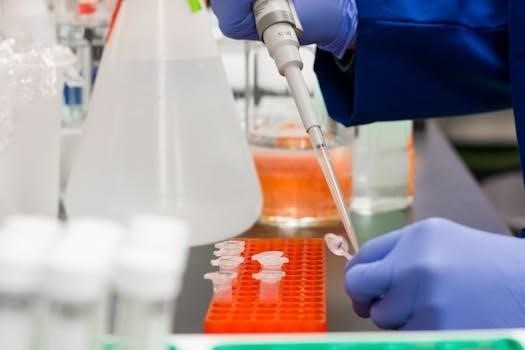Unit conversion is a fundamental skill in chemistry, enabling the expression of measurements in different units while maintaining accuracy. This process is crucial for solving problems, ensuring consistency, and facilitating effective communication of scientific data within the field.
The Importance of Unit Conversion in Chemistry
In chemistry, unit conversion is crucial because it allows scientists to express measurements in standardized units, ensuring consistency and comparability across experiments. Many chemical calculations, such as stoichiometry and gas laws, require all quantities to be in specific units. Accurate unit conversion prevents errors that can lead to incorrect results and flawed conclusions. Furthermore, it facilitates clear communication of research findings within the scientific community. Converting between different units, like grams to kilograms or milliliters to liters, enables precise calculations and meaningful comparisons of data. It’s an indispensable skill for any student or professional in chemistry.

Understanding Conversion Factors
Conversion factors are essential tools in chemistry for changing a quantity from one unit to another. They are ratios derived from equalities, allowing us to perform accurate unit conversions in chemical calculations and problem-solving scenarios.
Defining Conversion Factors
A conversion factor is a numerical ratio that expresses the relationship between two different units. It is used to convert a measurement from one unit to another without changing the value of the quantity. The conversion factor is based on an equivalence statement, such as 1 inch equals 2.54 centimeters. By multiplying a measurement by a properly chosen conversion factor, the units can be changed while preserving the original quantity’s magnitude. This technique is fundamental in chemistry for ensuring that calculations are performed using consistent units and for expressing results in the desired units.
Creating Conversion Factors
Creating conversion factors involves understanding the relationships between different units of measurement. To create a conversion factor, start with a known equivalence, like 1 meter equals 100 centimeters. Then, express this equivalence as a ratio. This can be done in two ways⁚ either 1 meter / 100 centimeters or 100 centimeters / 1 meter. The key is to choose the ratio that will cancel out the unwanted unit and introduce the desired unit when multiplied by the original measurement. By carefully setting up these ratios, accurate unit conversions can be achieved.

SI Units and Metric System
SI units and the metric system provide a standardized framework for measurements in chemistry. This system simplifies unit conversions through base units and prefixes, ensuring clarity and consistency in scientific calculations and data reporting.
Base SI Units in Chemistry
In chemistry, the International System of Units (SI) provides a foundation for accurate and consistent measurements. Key base SI units include the meter (m) for length, kilogram (kg) for mass, second (s) for time, and mole (mol) for the amount of substance. Additionally, Kelvin (K) measures temperature, and ampere (A) measures electric current. Candela (cd) represents luminous intensity. These base units are essential for expressing various chemical quantities. Understanding these units is crucial for performing accurate unit conversions and calculations in chemistry, enabling clear communication and reliable data analysis in scientific endeavors.
Metric Prefixes and Their Values
Metric prefixes are essential for expressing very large or small quantities in chemistry, simplifying numerical values and enhancing comprehension. Common prefixes include kilo (k) for 103, centi (c) for 10-2, milli (m) for 10-3, micro (µ) for 10-6, nano (n) for 10-9, and pico (p) for 10-12. These prefixes modify base units, such as grams (g) or liters (L), to represent quantities like kilograms (kg) or milliliters (mL). Understanding these prefixes and their corresponding values is crucial for accurate unit conversions and calculations in chemistry. Using metric prefixes allows scientists to work efficiently with measurements across various scales, ensuring precise and reliable results.

Dimensional Analysis Method
Dimensional analysis is a problem-solving method that uses the fact that physical quantities have dimensions. By tracking these dimensions during calculations, it ensures accurate unit conversions and proper problem setup in chemistry.
Applying Dimensional Analysis for Unit Conversions
To apply dimensional analysis, begin by identifying the given quantity and the desired unit. Next, establish a conversion factor that relates the given and desired units. Arrange the conversion factor so that the unwanted unit cancels out diagonally, leaving the desired unit. Multiply the given quantity by the arranged conversion factor. Ensure all units cancel correctly, leaving only the desired unit in the final answer. This method minimizes errors and provides a clear, step-by-step approach to unit conversions in chemistry, ensuring accuracy and clarity in calculations.
Multi-Step Unit Conversions
Multi-step unit conversions involve using a series of conversion factors to change a quantity from one unit to another. Begin by identifying the initial and final units. Create a roadmap of intermediate units needed to bridge the gap. Apply dimensional analysis, multiplying by conversion factors sequentially, ensuring each unwanted unit cancels out. Each step converts the quantity to a new unit, bringing it closer to the desired one. Continue until the final unit is reached. Double-check that all units cancel correctly, and perform the calculations accurately. This method is essential for complex conversions.
Common Unit Conversions in Chemistry
Common unit conversions in chemistry involve interchanging various units of measurement. These often include conversions related to length, mass, volume, and derived units such as density, enabling consistent data representation and problem-solving.
Converting Length, Mass, and Volume
Converting length, mass, and volume is fundamental in chemistry. Length conversions often involve millimeters to meters, or inches to centimeters, crucial for dimensional accuracy. Mass conversions, such as grams to kilograms or milligrams to grams, are essential for stoichiometric calculations. Volume conversions might include milliliters to liters or cubic centimeters to cubic meters, important for density and concentration calculations. These interconversions rely on established conversion factors and the dimensional analysis method. Mastering these conversions ensures precision and consistency in quantitative chemical analyses and problem-solving. Accurate conversions are vital for experimental work and data interpretation.
Converting Derived Units (e.g., Density)
Converting derived units, such as density, involves multiple unit conversions simultaneously. Density, typically expressed as mass per unit volume (e.g., g/mL), often requires converting both mass and volume units. For example, converting g/mL to kg/L necessitates converting grams to kilograms and milliliters to liters. This involves applying multiple conversion factors sequentially. Dimensional analysis is crucial for ensuring accurate conversions of derived units. These conversions are essential in chemistry for comparing substances, calculating concentrations, and solving complex problems involving intensive properties. Mastery ensures accurate data interpretation and problem-solving. Attention to significant figures is also critical.
Practice Problems and Examples
Practice problems and examples are essential for mastering unit conversions. Solving diverse problems reinforces understanding and builds confidence. Detailed solutions provide guidance, while worksheets offer opportunities for independent practice and skill development in chemistry.
Example Problems with Solutions
Example problems with solutions are critical for understanding unit conversion in chemistry. These examples demonstrate the step-by-step application of conversion factors and dimensional analysis to solve real-world problems. Each example problem should clearly present the initial measurement, the desired unit, and the conversion factors used. The solutions should show the cancellation of units, leading to the final answer with the correct unit and appropriate significant figures. Such examples help students grasp the logic behind unit conversions, build problem-solving skills, and gain confidence in their ability to tackle complex chemistry calculations effectively and accurately.
Worksheet Resources for Practice
Worksheet resources for practice are essential for mastering unit conversions in chemistry. These worksheets provide a variety of problems, ranging from simple one-step conversions to more complex multi-step conversions involving different units and derived quantities. The worksheets should include a mix of metric-metric, metric-imperial, and derived unit conversions, such as density and molar mass conversions. They often include answer keys, allowing students to check their work and identify areas where they need further practice. Regular practice with these worksheets reinforces the concepts of dimensional analysis and conversion factors, improving both speed and accuracy in solving unit conversion problems.

Significant Figures in Unit Conversions
Significant figures are crucial in unit conversions to maintain the precision of measurements. Rules dictate how many digits to retain after calculations, ensuring accurate representation of experimental data and avoiding misleading results.
Rules for Significant Figures During Conversions
When performing unit conversions, adhering to significant figure rules is essential for maintaining accuracy. Count the significant figures in the initial measurement. Conversion factors, if exact (e.g., 1 inch = 2.54 cm), do not limit significant figures.
For non-exact conversion factors, use the same number of significant figures as the least precise measurement. Multiplication and division should result in an answer with the fewest significant figures from the original numbers. Addition and subtraction should be based on the least precise decimal place. Round the final answer appropriately to reflect the correct level of precision in calculations.
Rounding and Expressing Answers Correctly
After completing unit conversions, it’s crucial to round the final answer appropriately based on significant figures. If the digit following the last significant figure is 5 or greater, round up; otherwise, round down. Express the final answer with the correct units, ensuring clarity and avoiding ambiguity.
Use scientific notation when dealing with very large or very small numbers to maintain precision and readability. Always double-check the answer for reasonableness and consistency with the original values. Include units in all intermediate steps and the final result to track conversions accurately.
Online Resources and Tools
Numerous online resources, including conversion calculators, are available to assist with unit conversions in chemistry. These tools offer quick and accurate conversions, while PDF worksheets and tutorials provide additional practice and guidance.
Online Conversion Calculators
Online conversion calculators are indispensable tools for students and professionals in chemistry, providing a swift and accurate way to perform unit conversions. These calculators eliminate manual calculations, reducing the risk of errors and saving valuable time, especially when dealing with complex or multi-step conversions. Many calculators support a wide range of units relevant to chemistry, including length, mass, volume, density, and molar mass.
Furthermore, some advanced calculators incorporate significant figure rules, ensuring that the converted values maintain the appropriate level of precision. By leveraging these online resources, users can focus on problem-solving and data analysis.
PDF Worksheets and Tutorials
PDF worksheets and tutorials offer structured practice and guidance for mastering unit conversions in chemistry. These resources typically provide a series of problems ranging in difficulty, allowing students to progressively develop their skills. Tutorials often include step-by-step explanations of the dimensional analysis method, along with examples demonstrating how to apply conversion factors correctly.
Worksheets may also incorporate real-world scenarios, connecting unit conversions to practical applications in chemistry. By working through these materials, students can reinforce their understanding of the concepts and improve their problem-solving abilities. The portable nature of PDFs makes them accessible for learning.
